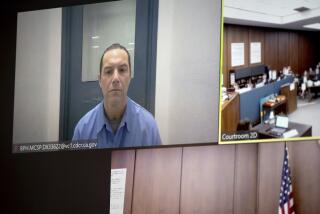Defense attorney in ‘Grim Sleeper’ trial questions LAPD crime lab DNA evidence

Lonnie Franklin Jr., 63, faces 10 counts of murder in the Grim Sleeper killings.
An attorney for the man accused of being the so-called Grim Sleeper serial killer questioned the reliability of DNA testing conducted by the Los Angeles police crime lab that prosecutors say links his client to some of the victims.
Questions about the DNA analysis were raised Tuesday as testimony continued in the trial of Lonnie Franklin Jr., who prosecutors say is responsible for a series of slayings.
Franklin faces 10 counts of murder in the deaths of nine women and a 15-year-old girl spanning more than 20 years. He also faces one count of attempted murder.
Franklin, 63, has pleaded not guilty.
Supria Rosner, a criminalist with the Los Angeles Police Department, testified that according to her work and analyses conducted by other criminalists, Franklin’s DNA profile matched DNA evidence found on the bodies of Barbara Ware and Bernita Sparks.
Ware was found shot to death in 1987, and Sparks was found dead two years later.
The likelihood of finding another person other than Franklin who has the same match is one in “81 quadrillion,” or 1 million times the population of Earth, she said.
But under sharp questioning, Franklin’s defense attorney, Seymour Amster, suggested that the procedures and policies used to conduct the analyses could have been faulty.
Were the testing instruments properly calibrated, Amster asked. Did analysts properly clean their workstations and were they working on several cases at a time?
Rosner responded that in her own review, she made sure that proper procedures were followed. There was nothing to indicate contamination of the DNA samples, she said.
Cristina Gonzalez, a criminalist with the Los Angeles County Sheriff’s Department, testified that DNA evidence retrieved from the body of 15-year-old Princess Berthomieux, who was found strangled and beaten to death in an Inglewood alley in 2002, also matched Franklin’s DNA profile.
Deputy Dist. Atty. Beth Silverman said during her opening statement last week that all of the victims were connected to Franklin either by DNA, firearm evidence or both.
Authorities began to piece together the controversial DNA evidence that pointed to Franklin after the body of Janecia Peters, 25, was found in a dumpster in 2007. Her attacker’s DNA matched evidence in two earlier cases, prompting investigators to begin matching DNA with killings from the 1980s to the more recent deaths, according to former LAPD Det. Dennis Kilcoyne.
In 2008, officials collected DNA data from state prisoners but failed to find a match with that of the Grim Sleeper.
A year later, then-state Atty. Gen. Jerry Brown approved a new technique called a “familial search” that allowed officials to check whether a crime suspect’s DNA partially matches that of anyone in the state’s offender DNA database.
The search came up with Franklin’s son. Detectives began following the elder Franklin and one of them, posing as a busboy, collected a half-eaten pizza crust, fork, napkin, drinking glass and cake crumbs discarded by Franklin at a restaurant.
Gonzalez is expected to continue testifying on Wednesday.
For more Los Angeles court news, follow @sjceasar.
See the most-read stories this hour >>
ALSO
Fugitive white supremacist captured in wine country
Father of bride who went missing after walking away from reception is found dead
Woman found blaring the horn of an idling freight train may have been ‘killing time’
More to Read
Start your day right
Sign up for Essential California for news, features and recommendations from the L.A. Times and beyond in your inbox six days a week.
You may occasionally receive promotional content from the Los Angeles Times.






